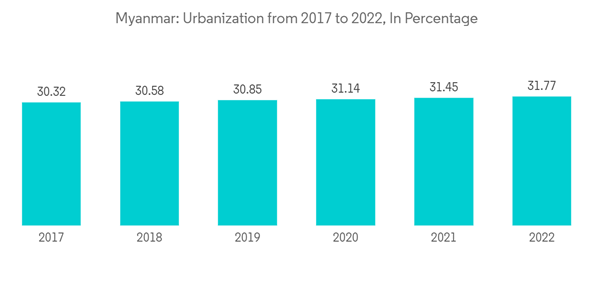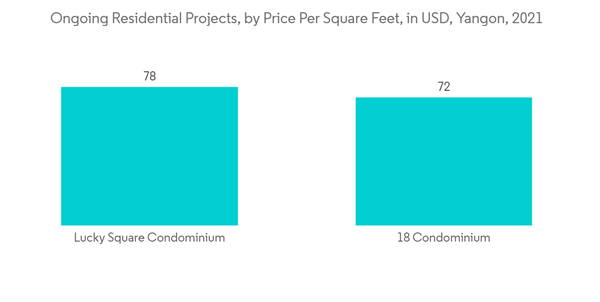The Myanmar Residential Real Estate Market size is estimated at USD 1.38 billion in 2024, and is expected to reach USD 2.09 billion by 2029, growing at a CAGR of 8.63% during the forecast period (2024-2029).
This product will be delivered within 2 business days.
Key Highlights
- The ongoing political turmoil and a rapidly rising third wave of COVID-19 cases severely impacted the Myanmar economy, which had already been weakened by the pandemic in 2020. Reduced mobility and incomes, protests, labor shortages, the ongoing disruption of critical business services, including logistics and telecommunications, and public services such as health and education have hit economic activity.
- Apartments and land parcels are always available for purchase. Year over year, the price hikes are gradual. The cost has not changed. As a result, the investors can only earn minimally. With time, both the dollar value and the price of gold are skyrocketing. Based on their purchase price, the buyers may perceive the profits. Making money quickly for housing is challenging. Because of this, many do not choose to invest in the real estate industry.
- With supposedly abolished epidemic restrictions, Myanmar is again accessible to foreign investment. Unfortunately, no one was waiting to purchase real estate in Yangon, which was bad news for local developers and stakeholders. As demand outstripped supply at the beginning of the previous decade, property values in Myanmar's former capital surged.
- The market is witnessing a rise in mixed-use developments that combine residential, commercial, and retail spaces. These developments offer convenience and a live-work-play lifestyle, attracting buyers and investors seeking integrated communities.
Myanmar Residential Real Estate Market Trends
Growth of Urbanization Driving the Market
- The ongoing effects of COVID-19, rising prices, and the political unrest in Myanmar devastated populations, forcing them to adapt and develop coping techniques. The typical migration pattern from rural to urban areas, which significantly contributes to the nation's socioeconomic development, has been particularly interrupted. Serious repercussions for migrants and their families become apparent when the effect of this movement pattern is examined in further detail.
- These crises have severely affected workers and businesses and immobilized the nation and its economy. There were problems with the supply chain, increased insecure employment, and the closing of numerous enterprises. According to ILO projections, Myanmar has 1.1 million fewer women and men working than it did in 2020.
- A projected 19.3 million women and men were employed in the first half of 2022, a slight increase from the 18.6 million predicted for 2021. However, the proportion of employed working-age individuals was still significantly lower than before the military takeover. The ILO also claims that there is a substantial decline in work quality. For many workers, the working circumstances are precarious due to severe invasions.
Yangon Public Rental Housing Driving the Market
- Yangon had immense potential to become a thriving model city for ASEAN cities. It was a metropolis with a vibrant social fabric, rising educational standards, a hospital environment favorable to business prosperity, a highly educated population, and local governments willing to undertake institutional change. The Ministry of Construction is undertaking public rental housing projects in Yangon, Mandalay, and Nay Pyi Taw, the highly populated cities, to better the socio-economic conditions of the people and generate work possibilities through the construction sector.
- On a 174-acre site in Yangon, a 3,104-unit public rental estate project would be built, with four five-story structures housing 194 apartments each. The government put millions of kyats into the project, and they hope to recoup their investment by charging long-term rentals to the general people. When the project is finished, the renters can rent a home in the housing estate at a reasonable rate. Each unit of the public rental housing will be 650 square feet wide. Each apartment contains two bedrooms, one living room, and one bathroom. The project area includes the market, school, clinic, playground, and park. Efforts are being made to lease some completed apartments in the project areas by the end of 2022. The finished units are now being installed with electricity and water supply facilities.
Myanmar Residential Real Estate Industry Overview
The Myanmar Residential Real Estate Market is fragmented due to numerous players in the market. Some major players are Marga Group, Shwe Taung Group, Dagon Group, Yoma Strategic Holdings, etc. The market is absorbing new projects, and modern housing seekers are expected to invest in the real estate sector. Thus, various companies focus on launching and marketing new projects, along with entertainment and stability for residents. The market is witnessing slow growth due to declining demand and increasing supply, which resulted in a considerable gap while exacerbating price pressures.Additional Benefits:
- The market estimate (ME) sheet in Excel format
- 3 months of analyst support
This product will be delivered within 2 business days.
Table of Contents
1 INTRODUCTION
4 MARKET DYNAMICS AND INSIGHTS
5 MARKET SEGMENTATION
6 COMPETITIVE LANDSCAPE
Companies Mentioned (Partial List)
A selection of companies mentioned in this report includes, but is not limited to:
- Marga Group
- Shwe Taung Group
- Yoma Strategic Holdings
- Myanmar Seilone
- Keppel Land
- Capital Development Limited
- SPS Mynamar
- Dagon Group
- Eden Group
- Excellent Fortune Development Group*
Methodology

LOADING...










